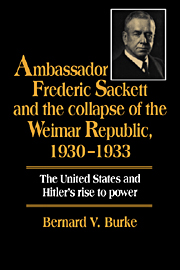Book contents
- Frontmatter
- Contents
- Acknowledgments
- Abbreviations used in the notes
- Introduction
- 1 A time of opportunity
- 2 American diplomacy, official and unofficial
- 3 The landslide election
- 4 Sackett takes the initiative
- 5 Sackett and the financial crisis
- 6 Perceptions of Nazism and communism, with an afterthought on fascism
- 7 One end, two paths: Brüning and Hitler in conflict
- 8 Efforts to sustain representative government in Germany
- 9 Sackett loses heart with Brüning's fall
- 10 The decline of Hitler and the Nazis
- 11 Through a glass darkly
- Conclusion
- Bibliography
- Index
7 - One end, two paths: Brüning and Hitler in conflict
Published online by Cambridge University Press: 30 September 2009
- Frontmatter
- Contents
- Acknowledgments
- Abbreviations used in the notes
- Introduction
- 1 A time of opportunity
- 2 American diplomacy, official and unofficial
- 3 The landslide election
- 4 Sackett takes the initiative
- 5 Sackett and the financial crisis
- 6 Perceptions of Nazism and communism, with an afterthought on fascism
- 7 One end, two paths: Brüning and Hitler in conflict
- 8 Efforts to sustain representative government in Germany
- 9 Sackett loses heart with Brüning's fall
- 10 The decline of Hitler and the Nazis
- 11 Through a glass darkly
- Conclusion
- Bibliography
- Index
Summary
Personal contacts with Nazis, especially with Hermann Göring and Joseph Goebbels, enabled Ambassador Sackett to focus on the Nazi party with greater understanding. In 1932, as Hitler's position grew in strength and importance, Sackett had less to say about the dangers of communism except as a means of getting the attention of the American government. Faced with the real possibility of Hitler in power, he now stressed the significance of the Nazis and placed greater emphasis on Brüning as the one man to save republican Germany. Sackett believed not only that Brüning could save the Weimar Republic, but also that he was the single person who could deliver Germany from the danger of Hitlerism. One failing in Sackett's analysis was his inability to divine the close similarity between Brüning's nationalistic goals and those of Hitler. When he focused on the dangers of Hitler and the need to help Brüning as much as possible, Sackett saw the two men as worlds apart. One significant difference between them continued to escape Sackett, who failed to see that Hitler, rather than wanting to achieve specific goals, sought power as an end in itself.
Sackett's appraisal of the two German leaders was faulty because he worked so hard to help the one against the other. Hitler appeared to be far removed from Brüning because the Nazi did everything in his power to thwart the chancellor. That distance between the two men seemed greater than ever as Brüning sought to win Hitler over to surmount yet another formidable task.
- Type
- Chapter
- Information
- Publisher: Cambridge University PressPrint publication year: 1995



